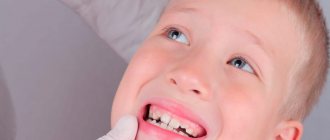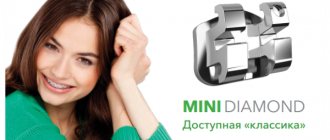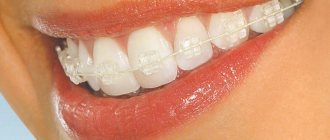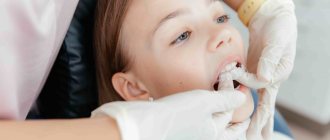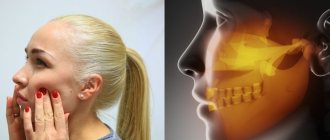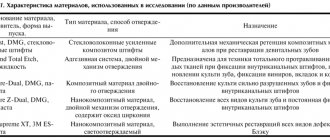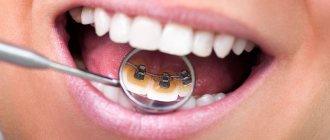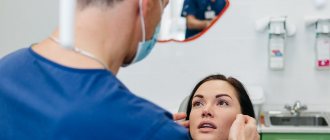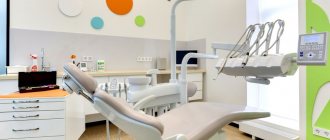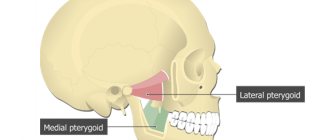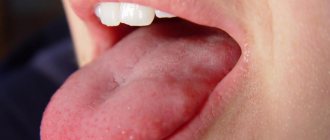9586
In orthodontic practice, special devices are quite successfully used to correct severe bite defects.
This is especially true in cases of mesial anomaly. Face masks are devices with two support clamps. As a rule, one is attached to the frontal part of the head, the second to the chin.
The Dilyar mask is a popular design of this type. Effectively aligns the position of the dentition. The arc is attached to the organs using threads that provide the necessary tension force and control the reliability of the device.
Indications
The device belongs to non-oral dental models; the need for their use is determined by the following indications on the recommendation of a specialist:
- mesial deviation of the bite with a pronounced anterior position of the lower element of the jaw row;
- correction of abnormal tooth fragments;
- inhibition of development and growth of one jaw relative to the other;
- as an additional therapy option when undergoing a course of treatment with braces.
Orthodontic dentistry
| Name of service | Price |
| Consultation with an orthodontist | 1000 ₽ |
| Diagnostic visit to an orthodontist with drawing up a treatment plan | 4400 ₽ |
| Production of control diagnostic models | 2000 ₽ |
| Single jaw orthodontic plate | 16000 ₽ |
| Double-jaw orthodontic appliance | 23000 ₽ |
| Orthodontic trainer | 17200 ₽ |
| Palatal expansion device | 28000 ₽ |
| Metal bracket system | 35000 ₽ |
| Sapphire bracket system | 55000 ₽ |
| Damon Q bracket system | 65000 ₽ |
| Damon Clear bracket system | 70000 ₽ |
| Activation of the bracket system (1 jaw) | 3000 ₽ |
| Removing the bracket system from one jaw | from 4300 ₽ |
| Retainer installation | 5100 ₽ |
| Diagnostics of treatment using StarSmile aligners Diagnostics includes: taking impressions of the jaws, photo protocol, image analysis (CT and TRG), treatment planning, building a computer model (Setup model) of the final result. You can learn about correcting your bite with orthodontic aligners in the article “You don’t need braces if aligners help!” | 10000 ₽ |
| Treatment with aligners. Correction of “light” defects (5-10 drops) | 80000 ₽ |
| Treatment with aligners. Correction of “medium” defects (11-20 caps) | 190000 ₽ |
| Treatment with aligners. Correction of “complex” defects (more than 21 caps) | 220000 ₽ |
| Re-making the mouthguard | 7500 ₽ |
Contraindications
The main contraindications to choosing this option for eliminating bite defects are:
- age of the patient - the device “works” only with children and adolescents, in whom the structure of the maxillofacial apparatus is not yet fully formed, and the bone tissue is susceptible to changes in the direction of growth;
- chronic diseases of the brain, disruption of the vestibular apparatus;
- respiratory dysfunction;
- mental disorders, epilepsy;
- hypertension in the acute stage.
It is worth noting that despite the rather extensive list of prohibitions on wearing the product, the pathologies listed above are quite rare in childhood.
This practically does not limit the use of the device for the correction of malocclusions.
Why do you need to correct your bite in children?
Many parents believe that malocclusion is purely a matter of aesthetics, and if the child’s appearance does not suffer, then there is no need to see a dentist. However, this opinion is erroneous. This pathology can lead to a lot of serious problems:
- improper closure of teeth leads to delayed development of the speech apparatus and impaired diction;
- the incorrect structure of the maxillofacial region leads to disruption of the respiratory process, which is why ENT diseases often appear;
- the risk of developing caries increases significantly, which sooner or later can lead to tooth loss;
- food is chewed incorrectly, resulting in digestive problems;
- Recent medical research proves that even posture disorders are possible, since everything in the body is interconnected.
Thus, at the first detection of deviations, it is necessary to show the child to an orthodontist. The sooner you start treatment, the easier and faster it will be.
How is a bite corrected in children?
Today, there are several methods for correcting dentofacial pathologies:
- myotherapy, which is a set of simple exercises. They are designed to restore muscle tone, due to which the jaws grow and develop correctly. As a result, permanent teeth will erupt correctly;
- use of orthodontic appliances. They are devices that allow you to forcefully move teeth so that they take the correct position;
- surgical intervention. This method is radical and is used only in exceptional cases. Through the efforts of surgeons, the jaw takes the correct position, after which a splint is applied. This method is rarely used in pediatric orthodontics;
- orthopedic correction. Special prosthetic structures are used, for example, veneers or crowns. This method is also rarely used to correct a child’s bite.
Types of orthodontic appliances for correcting malocclusion
The use of special orthodontic structures is the most popular method of correcting dentofacial anomalies. Such structures can be of various types:
- plates, which are removable structures. Their task includes expanding the jaw, shifting teeth, preventing crowding of teeth, ridding the child of bad habits that contribute to the development of pathology;
- trainers. Comfortable silicone designs that are worn for a certain period of time. They should be worn during the day for about an hour, and also worn during sleep;
- mouthguards. They are almost invisible, which eliminates psychological discomfort during treatment. In addition, they do not cause physical discomfort;
- bracket systems, which are non-removable structures. They consist of an arch with special locks that are glued to the teeth. Currently, they are the most common orthodontic appliances.
Advantages
Due to the specific design, the Dilyar mask has a number of advantages:
- Only one part of the device is located directly in the oral cavity - the thread, which is also quite easily removed. There are no bulky systems in the mouth that press on the mucous membrane and cause discomfort;
- simple dismantling of the external elements of the device - a specialist only needs to show how to use the device once, and the baby’s parents will be able to do it themselves;
- despite the apparent bulkiness, the product is comfortable to wear and its presence on the patient’s face is practically not felt, the effect of its presence is comparable, perhaps, to the presence of sunglasses on the bridge of the nose;
- with correct and regular use of the mask, a stable and long-term result is achieved - the position of the organs of the jaw row returns to a normal state, and the closure of the jaws occurs fully.
What is the vestibular plate, types and purpose.
Let us consider here in great detail the orthotic device.
At this address https://orto-info.ru/sistemyi-vyiravnivaniya-zubov/kappyi-elayneryi/byinina.html you can see photos of Bynin’s mouth guard.
Stages of bite correction at UniClinic
Our clinic has all the modern technologies that allow us to solve problems of malocclusion using world-class methods in dentistry.
- Diagnostic data – computed tomogram, TRG in lateral projection with calculations of skeletal parameters.
- Professional hygiene.
- Treatment of all carious lesions.
- Removal of failing teeth.
- Removal of wisdom teeth only when they prevent others from standing up straight.
- Removing diagnostic parameters for treatment planning.
- Installation of braces or issuance of transparent aligners (aligners).
- Monthly correction of braces or monthly examination in case of treatment with aligners.
- Removal of braces at the end of treatment and installation of retainers, which hold the teeth in their new position.
This stage is needed for 2-4 years to stabilize the result. As an alternative, you can use clear retaining mouth guards that must be worn at night.
Flaws
The device also has its disadvantages:
- low aesthetic level , due to which the device has to be used exclusively at home;
- a rather long course of treatment - due to the fact that the design is not used around the clock, the effect of its use is somewhat reduced, and the wearing time, accordingly, increases;
- the duration and complexity of adaptation is caused by the massiveness of the structure and the relative limitation of visibility. The person gets the feeling that the device is in the way. At the same time, it distracts the child’s attention from other, more interesting things and actions;
- the psychological factor is the presence of a constant desire to remove the mask, so this aspect of the issue is a mandatory requirement for the success of treatment.
If you follow your desires and often neglect to wear the device, there will be no result.
Petit designs
The device serves the same purpose as the above-described structures - to restore the natural bite and arrangement of teeth in the jaws by creating mesial-horizontal traction.
Its basis is a central steel axis made of round wire with caps at the ends to protect against accidental damage; in the center (at mouth level) there is a steel crossbar with bends or hooks for fixing the elastic (rubber) rod.
In terms of ease of use for therapeutic purposes, it is less preferred by orthodontists than the Dilyara apparatus.
Varieties
Each type of model is characterized by its own range of preferences, and can be recommended in the presence of a certain occlusion pathology.
In addition, this type of orthodontic devices is classified according to the method of fastening and tensioning the thread.
Moreover, absolutely all of the options discussed below belong to the category of therapeutic, mechanically active, orthodontic devices.
Universal mask with chin support
This version of the device is used most often because it perfectly stretches the jaws in the required direction.
With this method of support, the pressing force is concentrated in the area of the upper dentition, which makes it possible to qualitatively correct the mesial bite.
The device stimulates accelerated growth of the upper jaw, which accordingly increases the angle of the lower jaw. The basis of the therapeutic effect is the formation of extraoral traction.
Mask with cheek support
The design provides support fastenings on the forehead and cheeks, with the main fastening force falling precisely on the buccal area.
The device is adjustable depending on the size of the face. The mask is indicated for the correction of excessive crowding of teeth, as well as in the presence of pronounced interdental spaces in the lower jaw, mainly in its frontal area.
Indications for use of the Luri Apparatus and its manufacturing technology.
In this publication you will find characteristics of the Mershon Apparatus.
Follow the link https://orto-info.ru/sistemyi-vyiravnivaniya-zubov/lechebno-profilakticheskie-apparatyi/basharovoy.html if you are interested in the manufacturing procedure of the Basharova Apparatus.
Vertical mask large or small
Made from high-quality alloy steel and indestructible plastic. The choice in favor of such a device is made in case of a removable (in its early stages) or deciduous bite.
It has the main indication – all forms of incisor diocclusion (direct, deep, sagittal). Depending on the completeness of the diagnosis, the size of the structure is selected.
This takes into account the angle of the jaw, its length, width and depth of the jaw apparatus.
Horizontal mask large or small
The scope of application of this type of model is the correction of pronounced mesial occlusion (according to the international classification according to Engle, this is the third class).
Qualitatively corrects the mesial displacement of the molars of the lower jaw row up to one tubercle, as well as when diagnosing sagittal spaces or reverse overlaps of the incisal zone that do not go beyond the 2 mm limit.
Face mask in orthodontics – how it works and in what cases it is prescribed
A facial mask is another orthodontic device, which, along with braces, plates and aligners, is used to correct certain defects of the dentofacial apparatus, in particular to solve the problem of mesial occlusion. This is a special design, which, as a rule, has two supports - in the forehead and chin area, and less often - in the cheek area. Today, orthodontists use various types of such masks, each of which has its own purpose.
Principle of operation
The design features of the device provide convenient two-sided fastening, between which metal arcs are located vertically; their operating principle is quite simple.
If a thread is attached to an arch attached to the chin and frontal area, securely fixing it on the desired tooth, then as a result of such tension the product will be firmly fixed on the face, and the organs to which the threads are attached will gradually align their position according to the given tension trajectory.
The principle of operation of the device resembles the action of a rocker with two support zones. The role of the rocker is played by the thread, which, by creating tension, provides a double result.
By attracting the arc to a person’s face, it will not allow the product to come off during treatment, and at the same time, it has a therapeutic effect on the abnormal organs to which it is attached.
If the child’s age is quite young, only a facebow will be enough, and if we are talking about older teenagers or an adult patient, they are worn in combination with braces, mainly to correct pathologies of the lateral masticatory organs.
Where to start - diagnostics
Like any quality treatment, bite correction begins with a consultation with a doctor. It is necessary to make an appointment with a dentist or orthodontist, who will provide you with complete information, conduct a diagnosis, and then determine effective treatment methods.
Diagnostics usually includes the following steps:
- Orthopantomogram is a panoramic photograph of the jaws. The orthodontist needs such an image to determine the location of the jaws, understand the position and condition of the roots of the teeth and surrounding tissues.
- Teleroentgenogram - an X-ray image of the skull in a lateral projection is necessary for the orthodontist, first of all, to determine the direction of growth of the maxillofacial structures.
- Production of diagnostic plaster models of jaws, which are used for further calculation of orthodontic indices and indicators.
- Creation of a 3D treatment plan, visualization of the movement of your teeth throughout the entire treatment process, if treatment is planned on leveling aligners.
TOP 5 ways to correct malocclusion
Method number 1 - braces
Braces are very effective for correcting malocclusion at the age of formed bone structures. Braces are used in the treatment of adolescent and adult patients.
The design consists of small plates that are placed on the teeth in the form of separate elements; these elements are connected to each other by arches. The principle of tooth movement is mechanical. The orthodontist will control the movement of the teeth throughout the treatment, bringing them closer to the correct location.
Method No. 2 - aligners
In most cases, aligners will do an excellent job of correcting your bite. These are clear aligners that are made to move your teeth in the desired direction step by step.
Compared to braces, aligners are practically invisible on the teeth and are much easier to clean. But it is important to understand: the treatment plan is determined by the doctor based on the clinical situation. In some cases, an integrated approach to correcting the bite is used in several stages - braces and aligners.
Terms and rules of wearing
The time period for using the structure is about 3-4 months. More specifically, the treatment period is determined by the specialist, based on the degree of development of the pathology, and the need for the device to influence the teeth and jaw rows.
Since, due to aesthetic imperfections, a person does not have the opportunity to wear the model all the time, it is highly advisable to devote as much time as possible to this process while at home.
You need to try to ensure that the average number of hours per day when treatment is carried out is at least 10-12. This can be achieved if you use the device while you sleep and for several hours while you are awake.
After the device is removed, it must be thoroughly cleaned and hygiene measures taken to care for the oral cavity must be observed.
Duration of treatment with Dilyar mask
The degree of complexity of the defect to be corrected determines the duration of active use of the product. As a rule, this period is about three to four months.
One of the main conditions for the effectiveness of the method used is the systematic, 12-14-hour wearing of the Dilyar mask per day.
The device is stored in a special container where it is placed after hygienic treatment. It comes down to washing the structure in warm water and soap and drying it.
Good treatment results with the Dilyar mask are guaranteed with the correct selection of its model and full compliance with the rules of use.
Price
Depending on the design features of the model and the way it is attached, the cost of such a mask will vary in the price range from 4,000 to 9,500 thousand rubles.
Thus, a universal model with a standard fixation method will cost about 4-5 thousand, and the cost of a large vertical or horizontal version will reach 8-9 thousand rubles.
At the same time, the cost of the services of a specialist who will monitor the treatment ranges from 20-30% of the price of the device itself.
Forecast
The prognosis for the complete elimination of bite defects using this type of orthodontic leveling structures is quite optimistic.
If you follow the specialist’s recommendations and choose the right device option, you can completely get rid of pronounced anomalies after just a few months.
As for small children, the result comes after several weeks of therapy.
The principle of operation of the Dilyar mask and the expected result can be seen in the video.
Tubunger's "Sling"
The principle of operation of the Tubunger mask (in another transcription of Tubinger or Tübinger) does not differ from that for the design developed by Dilyar.
The difference lies only in the details of the design: this is an elastic, but quite hard, sling-shaped overlay for the chin tubercle of the lower jaw and an overlay made of the same material (plastic) for the frontal area of the face.
The pads are connected to each other using two metal rods that form the frame of the product and run along the central line - the axis of the face with a smooth protrusion-arc, leaving free space for the nose.
The system of screw-clamps allows, by changing the distance between the upper (frontal) and lower (chin) pads, to securely fix it to the dimensions of the patient’s face. The transverse bar at the level of the oral opening serves for external fastening of the intraoral rubber traction.
According to experts, unlike the Dilyar mask, where the frame is wider, this design is more “crowded” towards the middle, not providing freedom of maneuver when performing jaw traction, which is its disadvantage.
The device is intended for the correction of maxillodental dystopia, leading to difficulty in performing the chewing function of the teeth and disturbances in the formation of the facial skeleton.
